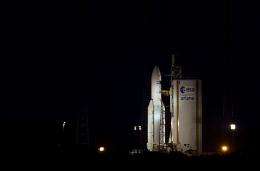Payload for international space station launched

A European Space Agency rocket blasted off Wednesday bearing a 20-tonne supply ship destined for a rendezvous with the manned International Space Station.
The super-charged Ariane 5 ES rocket departed from Kourou, French Guiana, just shy of 2151 GMT after a first attempt the day before was scratched at the last minute due to a minor technical glitch with the fueling system.
The liftoff had to take place at that time and no other.
"As we are going to the ISS so we have to leave the ground at a specific instant, so there is no launch window," explained Arianespance Chairman Jean-Yves Le Gall minutes before the launch.
Boosters fell away from the rocket 64 kilometres (49 miles) above Earth about 3.5 minutes after liftoff. Ten minutes into the flight, the vehicle was moving at 7.2 kilometres (4.5 miles) per second.
The Johannes Kepler -- named for the great 16th and 17th century German astronomer -- is the second Automated Transfer Vehicle (ATV) that Arianespace will have delivered to the ISS. The first was launched in March 2008.
Weighing in at more than 20 tonnes, it is by far the heaviest payload ever hoisted into orbit by the European Space Agency, nearly 15 times heavier than the pencil-thin trailblazer catapulted into space by ESA in 1979.
The automated vehicle is slated to supply the ISS with life-sustaining air, food and spare parts, and to reposition the sprawling station -- which, tugged by Earth's atmosphere, has lost altitude -- into its optimal orbit.
It is currently at around 360 kilometres (225 miles) and needs boosting to some 400 kilometres (250 miles).
After separating from the launch vehicle about an hour after liftoff, the ATV will be autonomous, using its own systems for energy and guidance in liaison with the control centre in Toulouse, southwestern France.
The unmanned supply ship is scheduled to navigate towards the ISS and dock with it automatically in about eight days, a feat of precision unmatched by any other space power.
"We will be working at a speed of around 28,000 kilometers (17,500 miles) per hour and our approach will be at seven centimetres (2.8 inches) a second, so although we are moving at this high speed, we will really be approaching the ISS very gently," said mission director Kris Capelle ahead of the launch.
Once emptied of its cargo, the supply ship will then be used as a spare room and for storage, easing the cramped conditions for the ISS crew.
In early June, the ATV will undock, laden with rubbish, human waste and unwanted hardware, and then go on a suicide plunge, burning up over the South Pacific.
ESA is scheduled to build five automated supply ships for the ISS.
Each successful mission boosts the case for scientists who want the ATV to be the template of a manned spacecraft, placing ESA on an equal footing with the United States, Russia and China.
Today's launch will be the 200th for Arianespace, which has lifted nearly 400 commercial and military satellites into space.
(c) 2011 AFP




















